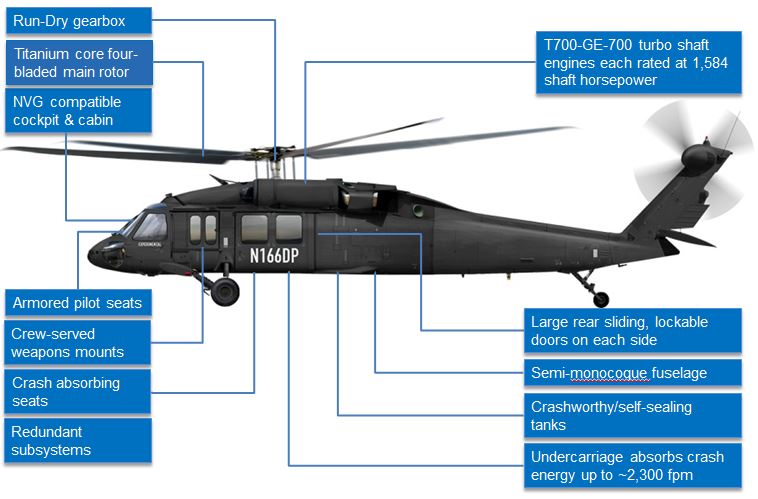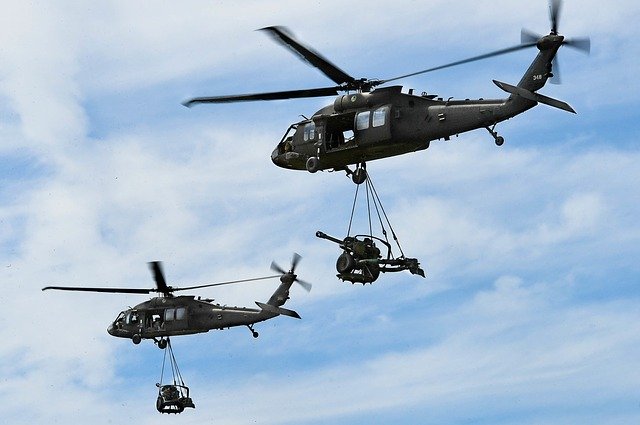The Ultimate Guide To Uh-60
Wiki Article
Uh-60 Fundamentals Explained
Table of ContentsGetting My Uh-60 To WorkUh-60 Can Be Fun For EveryoneUh-60 for DummiesUh-60 Can Be Fun For AnyoneSome Known Questions About Uh-60.Getting The Uh-60 To Work
The pilot can make the helicopter generate essentially lift utilizing a control called the, which raises or decreases the angle (likewise called) that all the blades make in the oncoming air as they spin about. For optimum lift, the blades ought to make a significantly high angle.Relocating the cumulative the other way moves the swash plates pull back, which pulls on the pitch web links and turns the blades to a shallower angle. At the end of the collective, there's a throttle linked by a cord to the engine. This resembles the accelerator of a cars and truck or the throttle of a motorbike, increasing or lowering the engine rate, directing the blades to make essentially lift.
This is where the swiveling of the helicopter back and forth occurs, which enables the rotor blades to give a steeper angle when they're on the left side of the craft than when they're on the. To put it simply, they generate more lift on the left, turning the craft to the right and also steering it because direction.
The resourceful swash plate mechanism translates the pilot's activities right into the appropriate activity of the rotor blades. Currently, the next time you see a helicopter take off, you recognize the mechanics behind it as well as can rest ensured that whoever is flying the craft understands what they're doing!
The Only Guide to Uh-60
This phase handles the research of tool rate effect on the lower surface of helicopter blades. It intends to suggest a representative limited aspect modeling (FEM) based on speculative observations of these sort of influences. Helicopter blades are big complex composite frameworks that run in a serious vibrant setting.A semicontinuous strategy, where certain shell aspects are paired with pole elements, was created. This technique gives a great representation of the damages mechanisms for slim composite structures constructed from two or three plies with the same alignment and product. In this paper, an extension of this semicontinuous strategy is described.
This technique is expanded to thicker woven composites with different ply alignments, with the introduction of certain cohesive aspects (uh-60). In the first component of this chapter, some details impact examinations are carried out and also examined in order to define the vital concerns that need to be represented in the advancement of the version.
The damage law as well as failing behavior are defined. A details interface element is offered. The modeling technique is validated on different impact tests.
Uh-60 Can Be Fun For Everyone
The helicopter visit this website comes down as a result of out of balance pressures: The weight of the helicopters is higher than the lift pressure of air. The Timeless Mechanics Division at St. Olaf University explains that even without the blades flexing upwards, there are equal and also opposite pressures acting upon the paper helicopter that create it to spin - uh-60.This high stress results in equal and contrary opposing forces that create the spin., a pair of equivalent as well as opposite pressures acting horizontally under each blade and on the body of the paper helicopter reason rotation.
The blades provide the lift as well as are aspects that trigger the helicopter to rotate. The width of the two blades with each other amounts to the size of the paper layout utilized to make the helicopter.
The width of the paper helicopter tail is one-third the width of the layout. The tail offers the paper helicopter trip stability.
The smart Trick of Uh-60 That Nobody is Talking About

Occasionally independent variables are not manipulated by why not look here the researcher however kept an helpful hints eye on to see how their changes may affect other variables. Time (seconds, days, years) is an independent variable that can be tracked to see exactly how it may influence other variables (e. g., the development of a plant). Dependent variables are what scientists observe, gauge, or count in an experiment.
Independent variables are factors that may transform a dependent variable. Managed variables are variables that the researcher does not enable to transform.
A basic two-rotor paper helicopter is a good style option to research this common issue. The scientist can manipulate any one of the four helicopter parts to establish what factors impact the trip time of a paper helicopter. By adjusting a part of the helicopter, scientists are adjusting the independent variable to figure out if this adjustment affects the moment the helicopter stays in the air (time in the air is the dependent variable).
Examine This Report on Uh-60

A variable is a characteristic or amount that can be gauged or counted in an experiment. Most experiments for this age represent three type of variables: independent, dependent, as well as managed. Independent variables are controlled by the researcher. These variables are changed and studied to establish if they are the cause in a cause-and-effect partnership.
Occasionally independent variables are not adjusted by the researcher however kept an eye on to see exactly how their modifications may influence various other variables. Time (secs, days, years) is an independent variable that can be tracked to see how it might impact other variables (e (uh-60). g., the development of a plant). Reliant variables are what researchers observe, measure, or matter in an experiment.
Independent variables are factors that may change a dependent variable. Regulated variables are variables that the researcher does not allow to alter.
Uh-60 Can Be Fun For Everyone
A simple two-rotor paper helicopter is a great layout option to study this typical problem. The scientist can manipulate any one of the 4 helicopter parts to determine what aspects influence the flight time of a paper helicopter. By adjusting a component of the helicopter, scientists are controling the independent variable to identify if this adjustment impacts the time the helicopter remains in the air (time in the air is the dependent variable).Report this wiki page